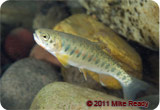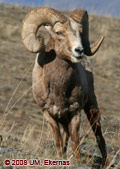Testing Mechanisms Underlying the Genetic Basis of Fitness

Summary:

Positive relationships between fitness traits (e.g., reproduction, survival, and disease resistance) and measures of genetic diversity such as individual heterozygosity, have long been widely reported in the ecology and evolution literature. In spite of an abundance of literature on the relationship between genotype or heterozygosity and fitness traits, there is limited information on the genetic basis of fitness and mechanisms causing so called heterozygosity-fitness-correlations (HFCs). We assess the number of genes influencing fitness traits and the relative importance of different genes (e.g., Thelan and Allendorf 2001; Da Silva et al. 2008; Luikart et al. 2008; Kardos et al. in prep.).

The bighorn sheep population at the National Bison Range (NBR) has been studied in detail for almost three decades (Hogg 1984; Hogg et al., 2006). Our recent study revealed strong relationships between inbreeding level and fitness traits (including survival and fecundity) in both males and females at NBR (Hogg et al., 2006). Studies on other bighorn populations have revealed relationships between male reproductive success and heterozygosity at candidate gene loci (Kardos et al., in prep), and between parasite load and heterozygosity at microsatellite loci located in disease related genes (Luikart et al., 2008).
We hope to use data on the cost of inbreeding and parasitism, and on the benefit of restored gene slow (genetic rescue) to model and predict the effects of inbreeding and outbreeding (heterosis) on population growth rate and population viability.
African buffalo is another system in which we are testing for heterozygosity fitness correlations. The buffalo is also an excellent species for testing the genetic basis of parasite resistance and immune system function.
Collaborators:
Fred Allendorf, Clint Muhlfeld, Vanessa Ezenwa, Jack (John) Hogg, Marty Kardos, Mike Schwartz
Publications:
- Da Silva, A., J.-M. Gaillard, N.G. Yoccoz, A.J.M. Hewison, M. Galan, T. Coulson, D. Allainé, L. Vial, D. Delorme, G. Van Laere, F. Klein, and G. Luikart. 2008. Heterozygosity-Fitness correlations revealed by neutral and candidate gene markers in roe deer from a long-term study. Evolution, in press. .pdf
- Hogg J.T. 1984. Mating in bighorn sheep: multiple creative male strategies. Science, 225: 526-529.
- Hogg, J.T., S.H. Forbes, B.M. Steele, and G. Luikart. 2006. Genetic rescue of an insular population of large mammals. Proceedings of the Royal Society. 273:1491-1499. .pdf
- Johnson. H.E., L.S. Mills, J.D. Wehausen, T.R. Stephenson, G. Luikart. 2011. From lambs to lambda: effects of inbreeding depression on recovery of endangered Sierra Nevada bighorn sheep. Conservation Biology, In press.
- Kardos M.D., Da Silva A., Hogg J.T., Allaine D., Yoccoz G., Luikart G. Candidate gene microsatellite diversity predicts male annual reproductive success in bighorn sheep. In Prep.
- Luikart, G., K. Pilgrim, J. Visty, V.O. Ezenwa, and M.K. Schwartz. 2008. Candidate gene microsatellite variation is associated with parasitism in wild bighorn sheep. Biology Letters, 4:228-231. .pdf
- Tallmon, D.A., G. Luikart, and R.S. Waples. 2004. The alluring simplicity and complex reality of genetic rescue. Trends in Ecology and Evolution, 19:489-496. .pdf
- Thelen G.C., Allendorf F.W. 2001. Heterozygosity-fitness correlations in rainbow trout: effects of allozyme loci or associative overdominance? Evolution, 55: 1180-1187. .pdf
